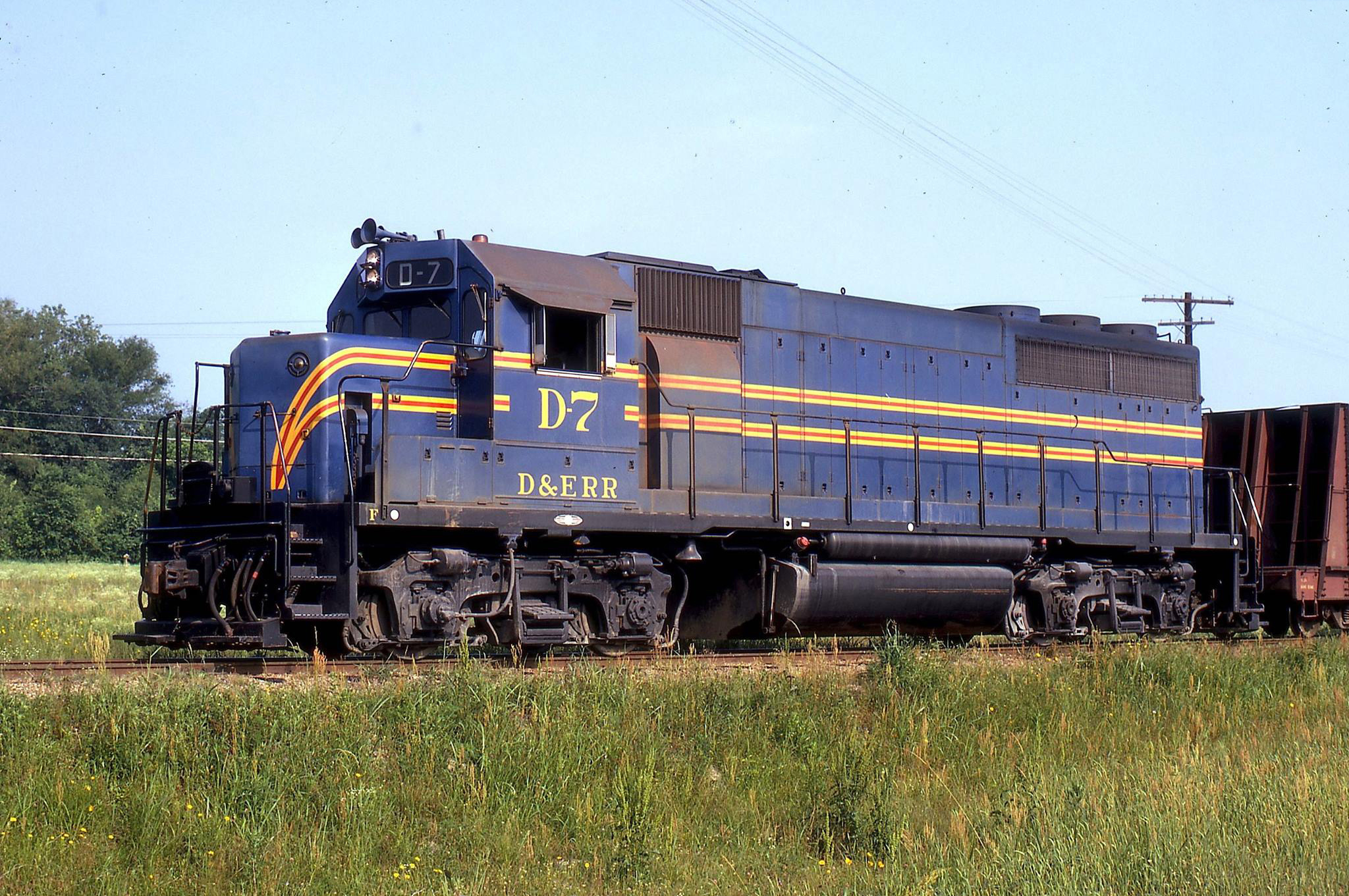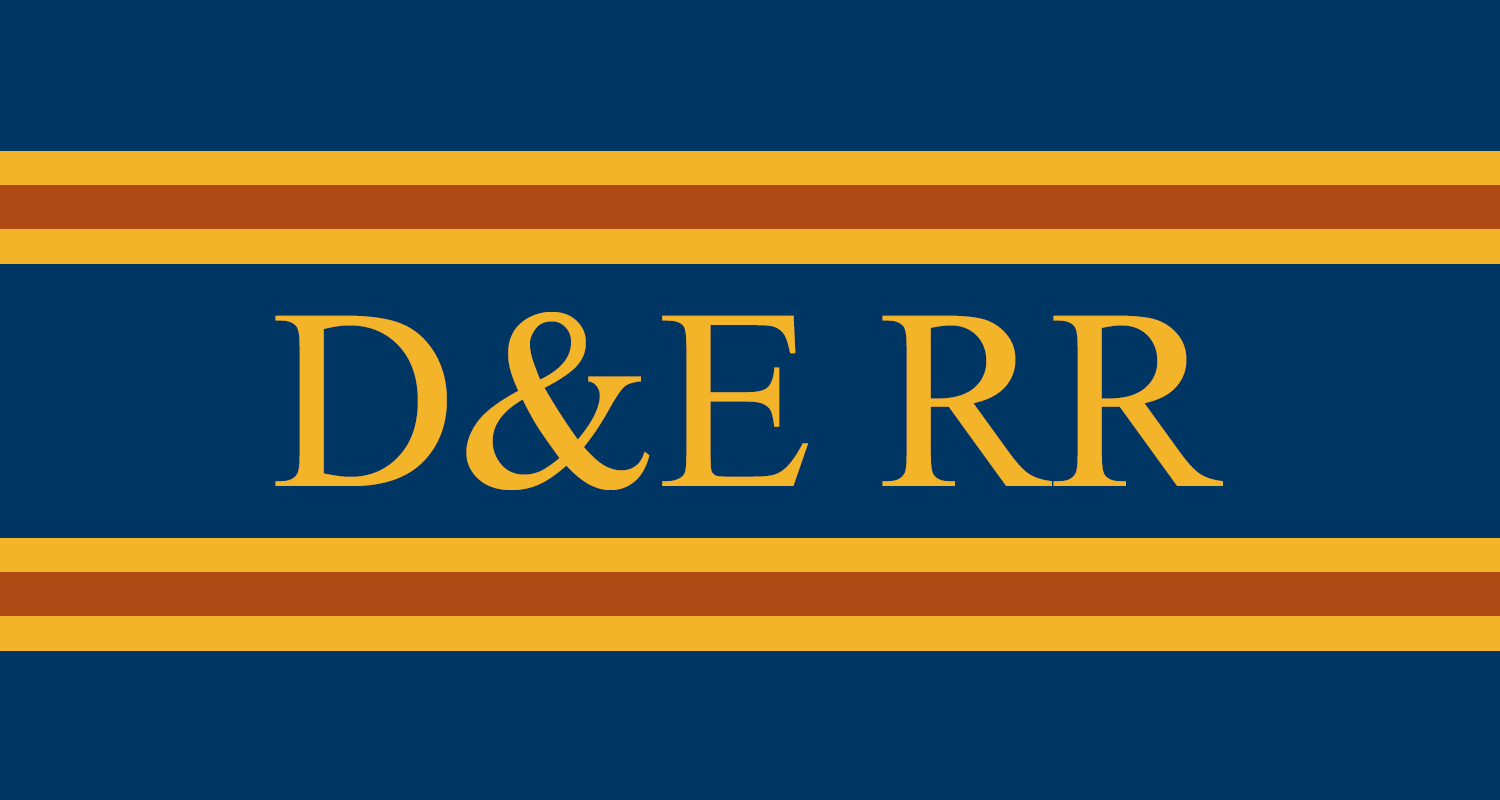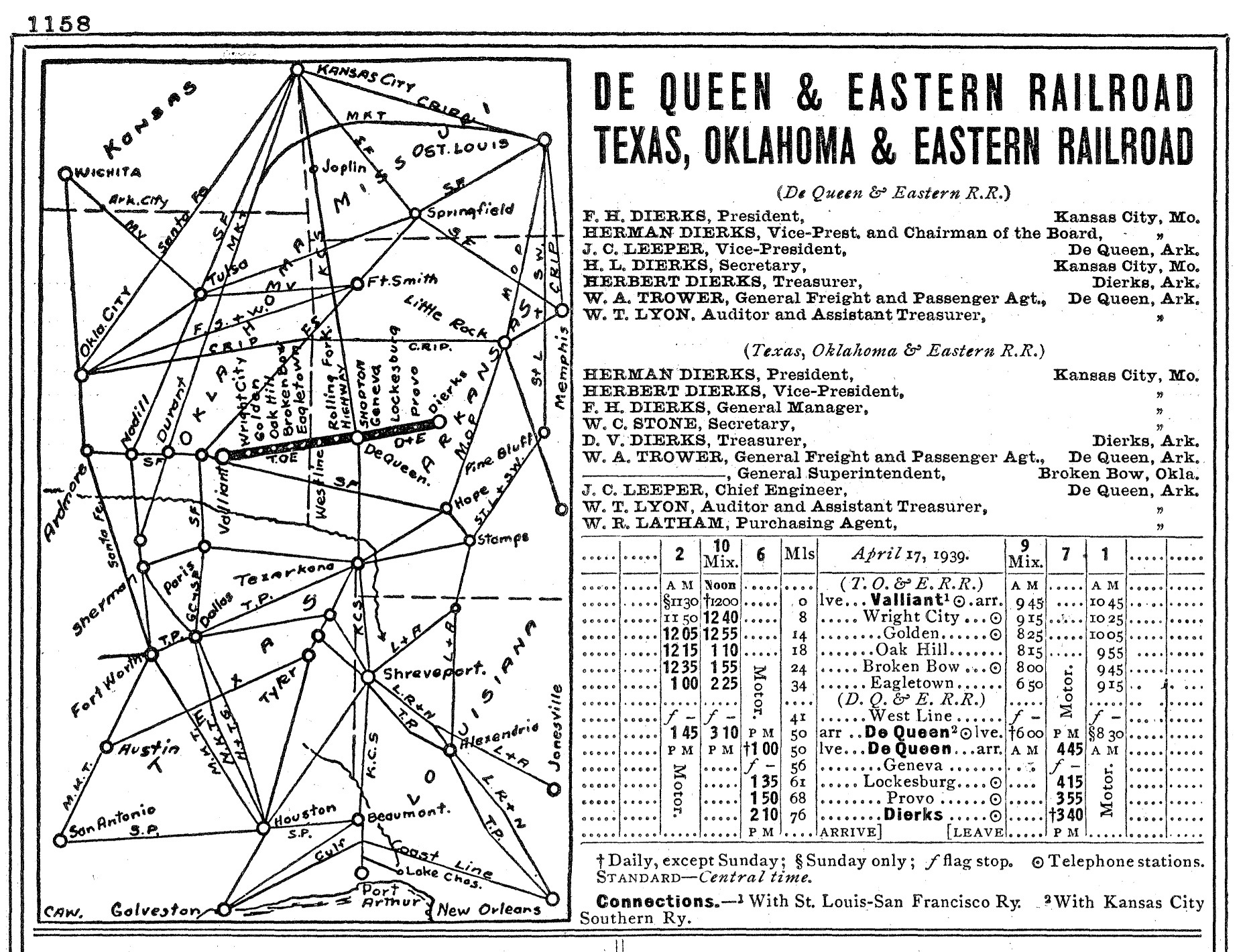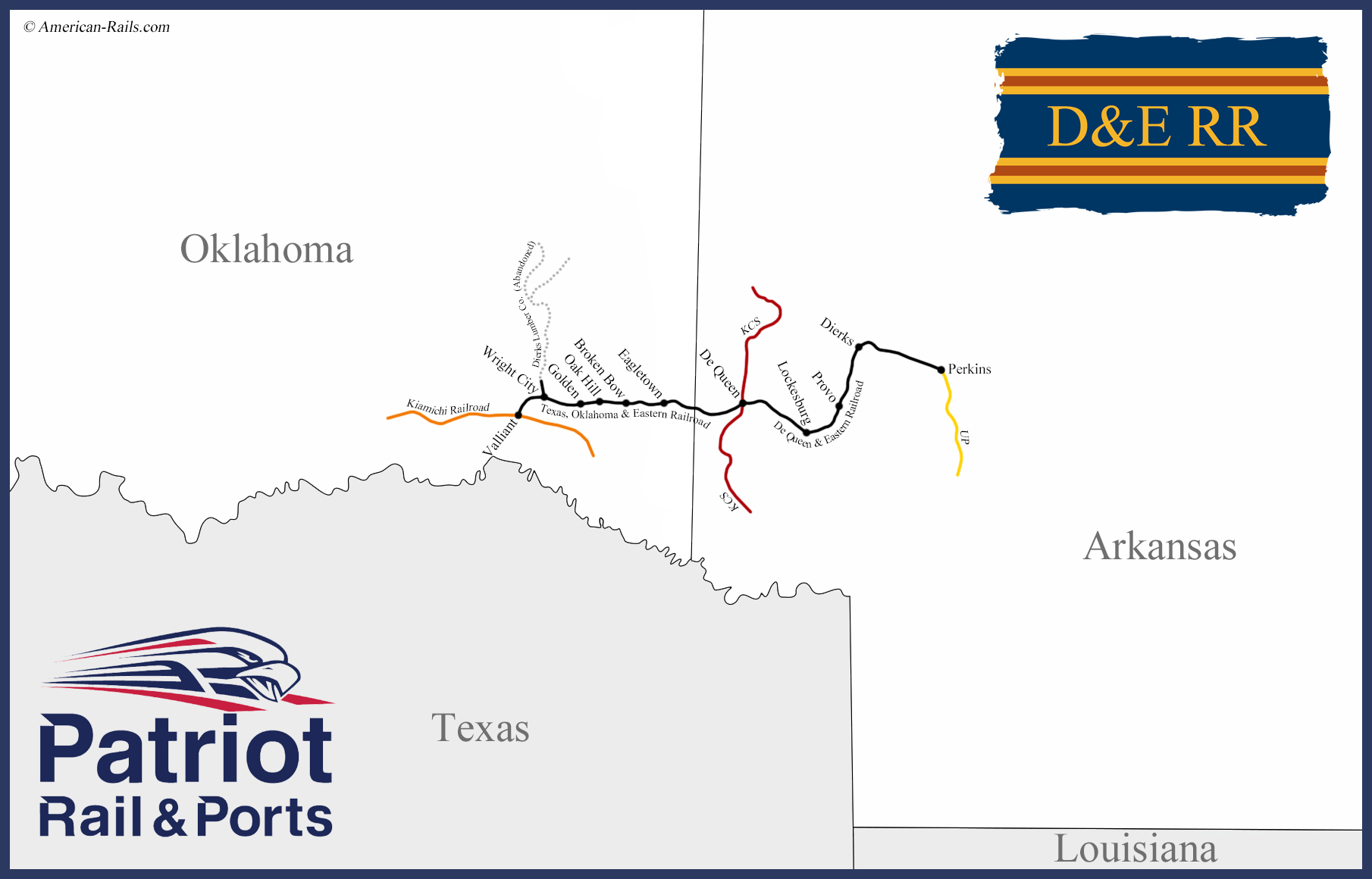De Queen and Eastern Railroad: Serving Arkansas Since 1900
Last revised: August 30, 2024
By: Adam Burns
The De Queen and Eastern Railroad (reporting marks, DQE) is a southern shortline that has
served Arkansas for more than 100 years. Its history can be traced to
the very beginning of the 20th century to serve the local timber industry.
It had only been in operation a decade or so when it acquired the nearby Texas, Oklahoma & Eastern Railroad, which would ultimately double its system size and the TO&E still remains a component of the company to this very day. Until the 1960s the road was privately owned.
That decade it was purchased by Weyerhaeuser, a major wood products company which wound up with a large consortium of short lines throughout the country (most have since been spun-off).
The DQ&E/TO&E remained controlled by the large corporation until only recently when it was purchased by Patriot Rail, a smaller version of a Genesee & Wyoming.
Most historic short lines of the DQ&E's size struggled or disappeared in the latter 20th century due to mergers, increasing competition, and governmental regulation. However, this railroad is unique.
Today, the property continues to transport wood-related products although it now also moves several other types of freight, hauling more than 35,000 carloads annually.
Photos
History
The history of the De Queen And Eastern Railroad begins with its chartering on September 22, 1900 to build a line roughly 50 miles east of De Queen, Arkansas where it would establish a connection with the Kansas City Southern.
Within three years the route was opened as far as Provo (19 miles) and by 1906 it had reached Dierks boasting a 27-mile system.
Logo
Shortly after the DQ&E opened its latest extension the nearby Texas, Oklahoma & Eastern was chartered on October 21, 1910 to build a railroad from Valliant, Oklahoma (where it would interchange with the St. Louis-San Francisco Railway, the "Frisco") eastward to De Queen.
Before the new TO&E could even begin any major building of its proposed route the DQ&E took over controlling interest in the railroad.
By 1912 the new TO&E had reached Broken Bow a distance of 24 miles and by 1921 its route was essentially completed when it reached West Line at the Oklahoma/Arkansas state line giving it a 39.3 system.
Shortly before opening this line the DQ&E had opened another extension from De Queen to West Line (9 miles) which allowed the two roads to complete a connection with each other and provide a through route from Dierks to Valliant.
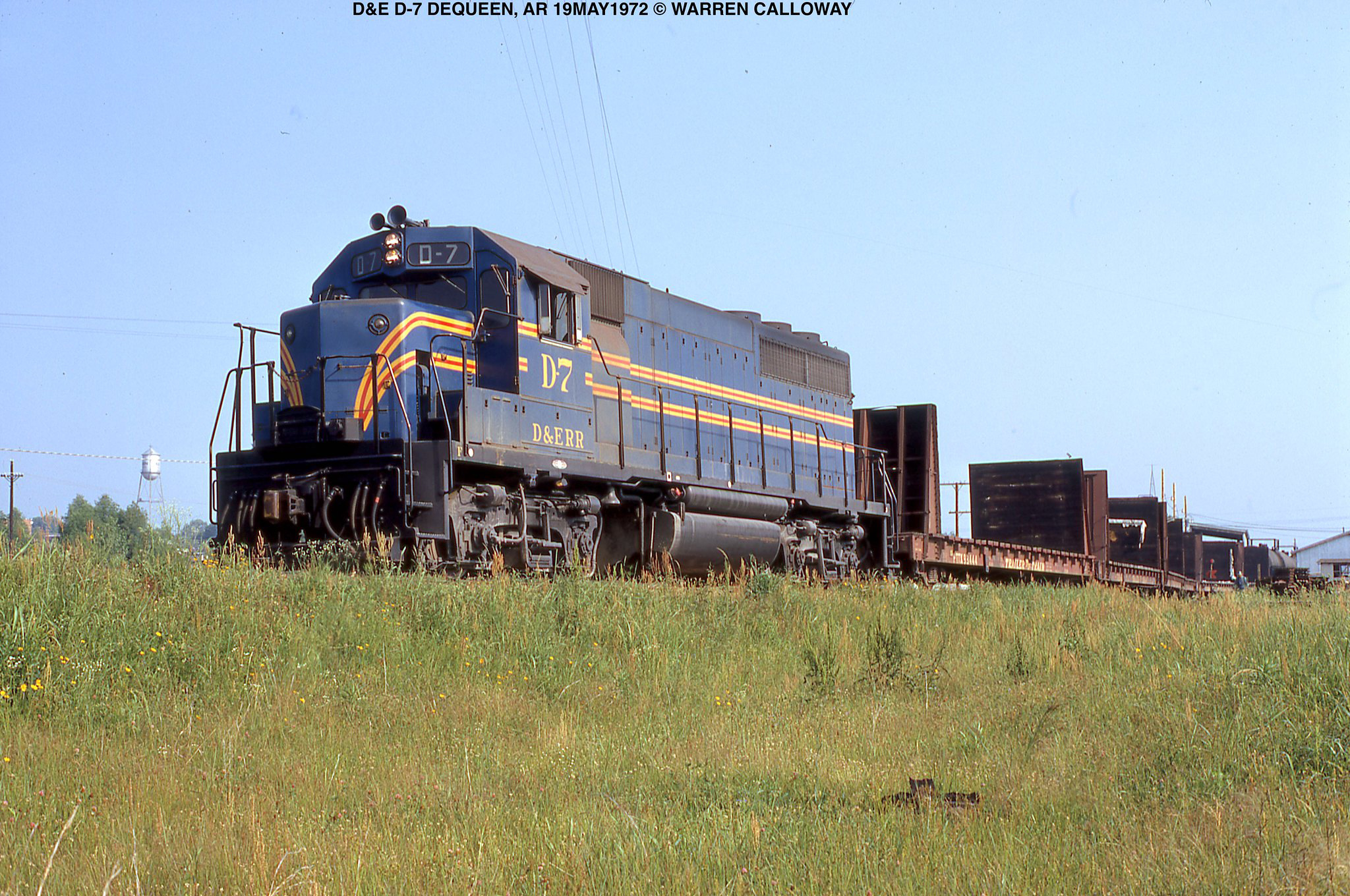 De Queen & Eastern GP40 #D-7 has a cut of pulpwood flatcars at Dierks, Arkansas on May 19, 1972. Warren Calloway photo.
De Queen & Eastern GP40 #D-7 has a cut of pulpwood flatcars at Dierks, Arkansas on May 19, 1972. Warren Calloway photo.Interestingly, it would take another 40 years until the railroad was finished; in 1957 the last 9 miles from Dierks to Perkins was completed where the DQ&E opened a new interchange with the Missouri Pacific.
With this extension opened both the DQ&E and TO&E offered shippers an 84.4-mile system with connections to three major Class I carriers (KCS, Frisco, and MoPac).
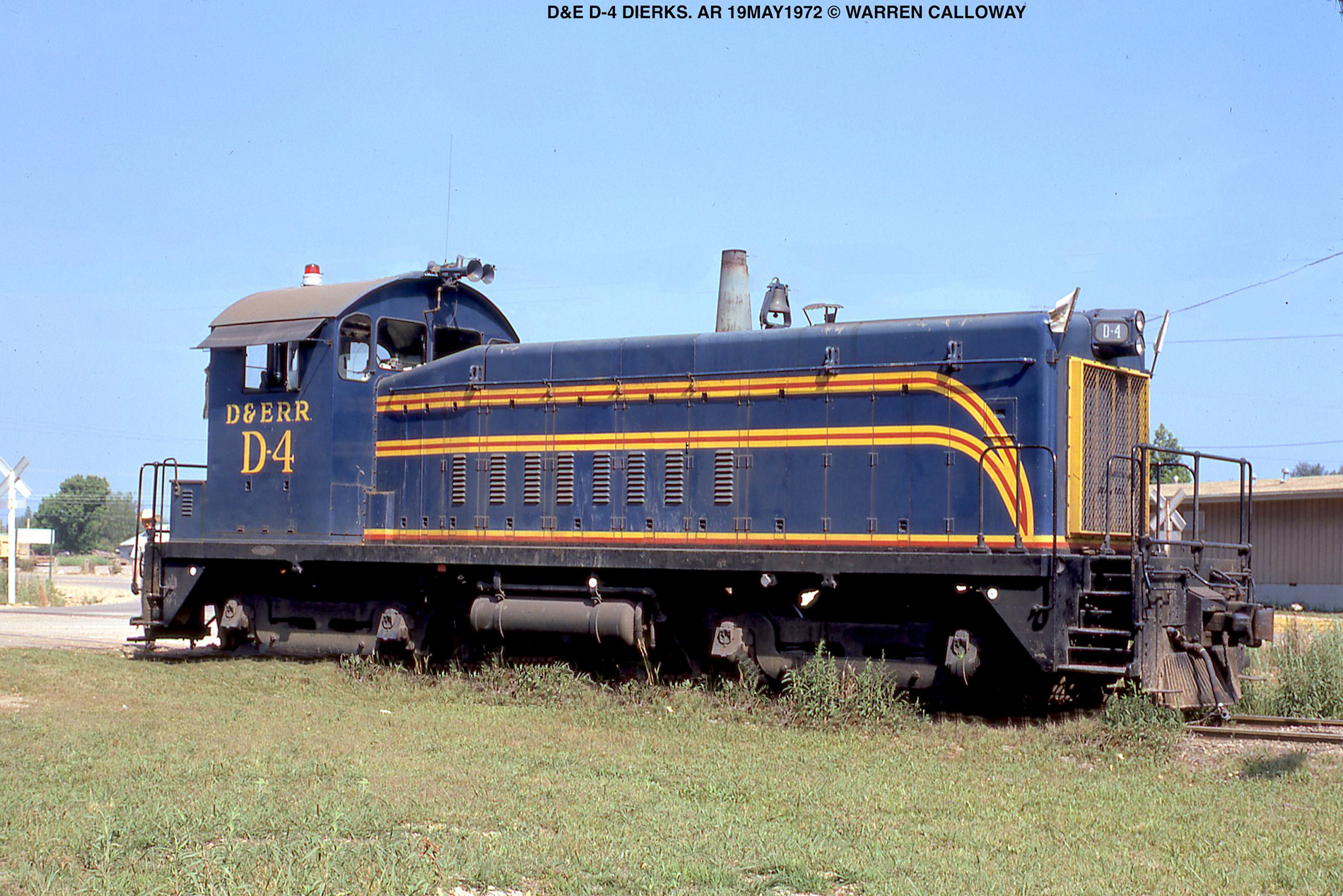 De Queen & Eastern SW900 #D-4 appears to be performing switching work in Dierks, Arkansas on May 19, 1972. Warren Calloway photo.
De Queen & Eastern SW900 #D-4 appears to be performing switching work in Dierks, Arkansas on May 19, 1972. Warren Calloway photo.From an early date the De Queen and Eastern Railroad was owned by the Dierks Lumber & Coal Company, a family-owned operation that was managed and staffed by various relatives (this also held true for subsidiary Texas, Oklahoma & Eastern).
In general, both roads were relatively profitable moving a mix of freight ranging from lumber and paper to coal, grain, and various LCL shipments (less-than-carload). Surprisingly, though, each short line did this using just a few locomotives through the 1930s.
This also included passenger operations, which were normally so sparse that it only required a single coach to fulfill daily needs (between both railroads there was only two coaches, a combine, and an RPO).
The light nature of demand not surprisingly saw such services end well before many other railroads, with the last passenger run occurring in 1948.
System Map (1940)
One of the biggest changes for the system following World War II was new ownership; the Dierks family gave up their control of the De Queen and Eastern Railroad selling out to the Weyerhaeuser Company in 1966.
By this time, of course, the road had long since dieselized. Its first unit had arrived in March of 1951, an EMD SW8 #D3. This was followed by SW900 #D4 in May of 1954 and then SW1000 #D5 in February of 1960.
System Map (Present Day)
As it turns out, switchers were not the only diesels the DQ&E utilized; it purchased new GP35 #D6 in May of 1964 as well as GP40s #D7 and #D12 between 1966 and 1971.
The rest of its motive power fleet it would acquire used and while most units were of General Motors' lineage a few included small General Electric switchers.
Locomotive Roster
| Builder | Model Type | Road Number | Date Built/Notes | Quantity |
|---|---|---|---|---|
| EMD | SW8 | D3 | 3/1951 | 1 |
| EMD | SW900 | D4 | 5/1954 | 1 |
| EMD | SW1000 | D5 | 2/1960 | 1 |
| EMD | GP35 | D6 | 5/1964 | 1 |
| EMD | GP40 | D7, D12 | 1966, 1971 | 2 |
| GE | 44-Tonner | D9 | Ex-PRR | 1 |
| GE | 45-Tonner | D11 | Ex-US Army | 1 |
| EMD | SW9 | D17 | Ex-P&LE | 1 |
| EMD | GP40-2 | D20, D20 | 9/1974 | 2 |
| EMD | GP38-2 | D27, D28 | Ex-Curtis, Milburn & Eastern | 2 |
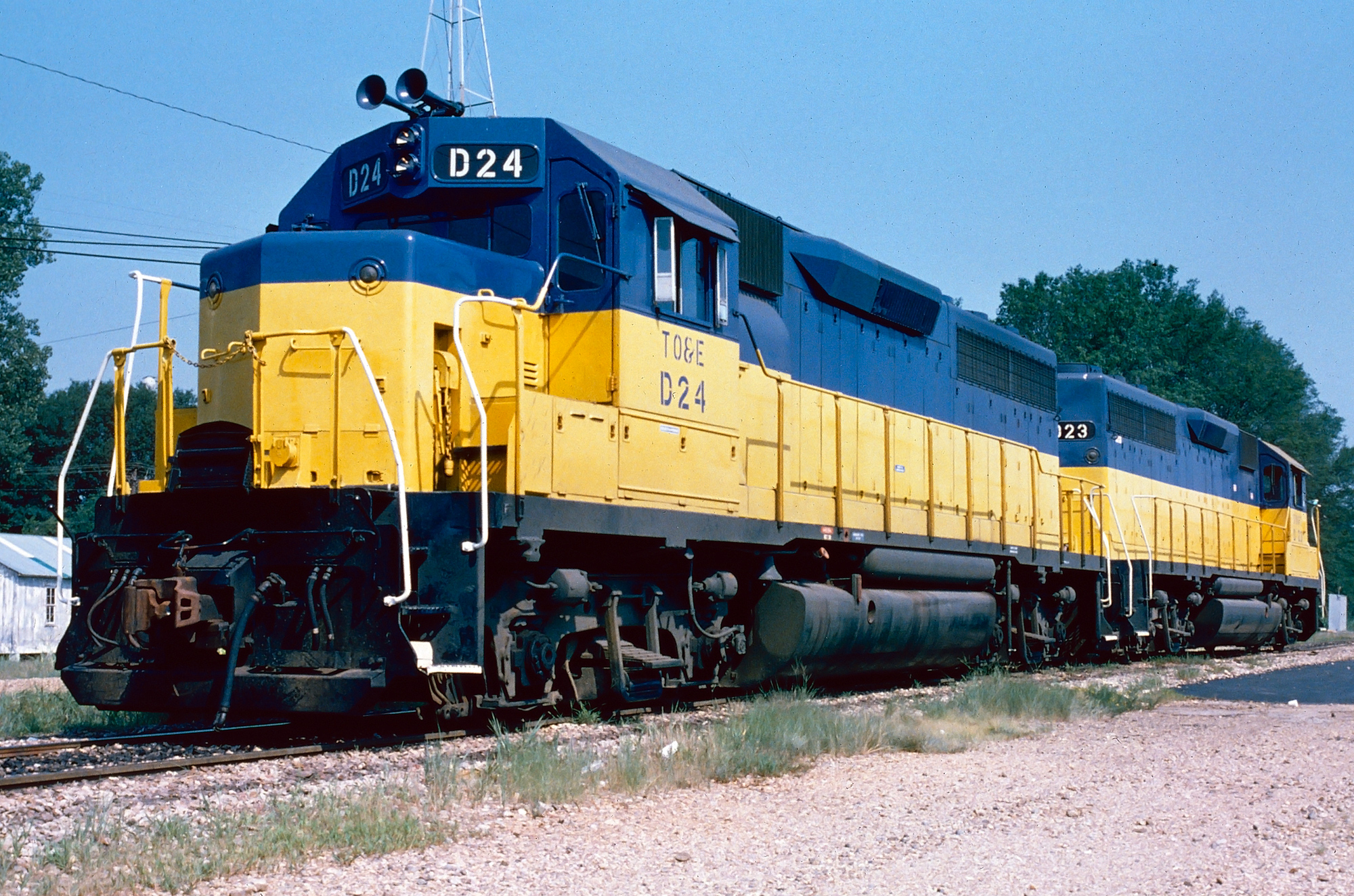 Texas, Oklahoma & Eastern GP40's #D-23 and #D-24, circa 1984. These units were built as Penn Central #3162 and #3123. Mike Bledsoe photo. American-Rails.com collection.
Texas, Oklahoma & Eastern GP40's #D-23 and #D-24, circa 1984. These units were built as Penn Central #3162 and #3123. Mike Bledsoe photo. American-Rails.com collection.Weyerhaeuser retained ownership of the De Queen & Eastern for more than 30 years itself before finally selling its remaining short line portfolio in 2010 to Patriot Rail; the deal was completed on August 2nd that year and along with the DQ&E included the Golden Triangle, Mississippi & Skuna Valley, Columbia & Cowlitz, and Weyerhaeuser Woods.
Under Patriot the short line still moves timber products like plywood chips and pulpboard but also includes corn, stone, soybeans and chemicals.
From this traffic its current customer base includes International Paper, Weyerhaeuser, Dow Chemical, CertainTeed, Cargill, JM Huber and Tyson Foods.
Recent Articles
-
Kentucky Scenic Train Rides At KRM!
Jan 09, 26 11:13 PM
Located in the small town of New Haven the Kentucky Railway Museum offers a combination of historic equipment and popular excursions. -
Washington "Wine Tasting" Train Rides
Jan 09, 26 08:53 PM
Here’s a detailed look at where and how to ride, what to expect, and practical tips to make the most of wine tasting by rail in Washington. -
Kentucky's - Wine Tasting - Train Rides
Jan 09, 26 08:21 PM
Kentucky, often celebrated for its rolling pastures, thoroughbred horses, and bourbon legacy, has been cultivating another gem in its storied landscapes; enjoying wine by rail. -
Kentucky's - Murder Mystery - Dinner Train Rides
Jan 09, 26 01:12 PM
In the realm of unique travel experiences, Kentucky offers an enchanting twist that entices both locals and tourists alike: murder mystery dinner train rides. -
Utah's - Murder Mystery - Dinner Train Rides
Jan 09, 26 01:05 PM
This article highlights the murder mystery dinner trains currently avaliable in the state of Utah! -
North Carolina Dinner Train Rides At NCTM!
Jan 09, 26 12:51 PM
Tucked into the Piedmont town of Spencer, the North Carolina Transportation Museum is the kind of place that feels less like a typical museum and more like a living rail yard that never quite stopped… -
Tennessee Dinner Train Rides At The TVRM!
Jan 09, 26 12:39 PM
Tucked into East Chattanooga, the Tennessee Valley Railroad Museum (TVRM) is less a “museum you walk through” and more a railroad you step aboard. -
New York Scenic Train Rides On The A&A!
Jan 09, 26 11:20 AM
The A&A is both a common-carrier short line moving freight and a heritage railroad hosting popular excursion trains, all on the same storied right-of-way. -
Pennsylvania Scenic Train Rides In Hollidaysburg!
Jan 09, 26 11:14 AM
Tucked into the Juniata River valley just south of Altoona, the Everett Railroad offers one of the most approachable—and photogenic—heritage-rail experiences in Pennsylvania -
Montana Dinner Train Rides Near Lewistown!
Jan 08, 26 03:03 PM
The Charlie Russell Chew Choo turns an ordinary rail trip into an evening event: scenery, storytelling, live entertainment, and a hearty dinner served as the train rumbles across trestles and into a t… -
Alabama's - Murder Mystery - Dinner Train Rides
Jan 08, 26 02:19 PM
There is currently one location in the state offering a murder mystery dinner experience, the Wales West Light Railway! -
Rhode Island's - Murder Mystery - Dinner Train Rides
Jan 08, 26 01:43 PM
Let's dive into the enigmatic world of murder mystery dinner train rides in Rhode Island, where each journey promises excitement, laughter, and a challenge for your inner detective. -
Florida's - Wine Tasting - Train Rides
Jan 08, 26 01:13 PM
Wine by train not only showcases the beauty of Florida's lesser-known regions but also celebrate the growing importance of local wineries and vineyards. -
Texas's - Wine Tasting - Train Rides
Jan 08, 26 12:30 PM
This article invites you on a metaphorical journey through some of these unique wine tasting train experiences in Texas. -
New York's - Wine Tasting - Train Rides
Jan 08, 26 11:32 AM
This article will delve into the history, offerings, and appeal of wine tasting trains in New York, guiding you through a unique experience that combines the romance of the rails with the sophisticati… -
California Dinner Train Rides In Sacramento!
Jan 08, 26 11:21 AM
Just minutes from downtown Sacramento, the River Fox Train has carved out a niche that’s equal parts scenic railroad, social outing, and “pick-your-own-adventure” evening on the rails. -
New Jersey Dinner Train Rides In Woodstown!
Jan 08, 26 10:31 AM
For visitors who love experiences (not just attractions), Woodstown Central’s dinner-and-dining style trains have become a signature offering—especially for couples’ nights out, small friend groups, a… -
Nevada's - Murder Mystery - Dinner Train Rides
Jan 07, 26 02:12 PM
Seamlessly blending the romance of train travel with the allure of a theatrical whodunit, these excursions promise suspense, delight, and an unforgettable journey through Nevada’s heart. -
West Virginia's - Murder Mystery - Dinner Train Rides
Jan 07, 26 02:08 PM
For those looking to combine the allure of a train ride with an engaging whodunit, the murder mystery dinner trains offer a uniquely thrilling experience. -
Kansas's - Murder Mystery - Dinner Train Rides
Jan 07, 26 01:53 PM
Kansas, known for its sprawling wheat fields and rich history, hides a unique gem that promises both intrigue and culinary delight—murder mystery dinner trains.

